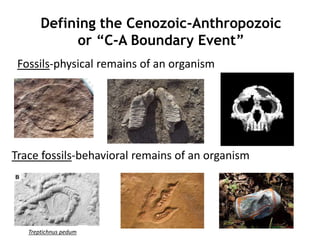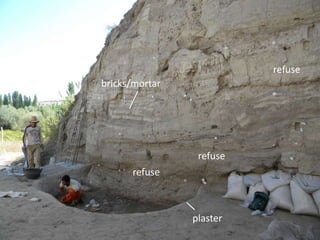"Anthropocene" is Too Modest to Describe Human Earth Impact
- 1. Fossils-physical remains of an organism Defining the Cenozoic-Anthropozoic or ŌĆ£C-A Boundary EventŌĆØ Trace fossils-behavioral remains of an organism Treptichnus pedum
- 2. Figure 3. Overview of Tucson's Overall Waste Composition, 2012 ure 4, organic waste is estimated to make up over half of TucsonŌĆÖs residential sector mposed, predominantly, of yard debris (24.5%) and food (17.6%). Paper is the next class at almost 19%. Mixed paper and textiles, both recyclable material categories, each 6% of residential waste. Based on data derived from waste characterization studies her communities, Cascadia estimates that the municipal average for textiles disposed is weight. Figure 4. Overview of Tucson's Residential Waste Composition, 2012 0.2 x 40 kg x 5 billion = 1 x 109 kg 300 kg/yr/person x 0.28 x 50 yr x 5 billion = 2 x 1013 kg Mass of trash Mass of bone 1013/109 = 10,000:1
- 3. Brief History of Trash first stone tools first agriculture high civilizations industrialization
- 5. The Very Base of the C-A Boundary EventŌĆöthe first trash
- 6. Awash gravel alluvial sand bank OGS-7 tuff: 2.53┬▒0.15 Ma Middle Pleistocene gravel
- 7. Awash gravel OGS-7 tuff: 2.53┬▒0.15 Ma Middle Pleistocene gravel Gauss Chron Matuyama Chron 2.58 Ma
- 8. In situ artifacts at OGS-7: the oldest stone artifacts 2.58 Ma
- 9. Stone Tool Making Traditions Oldowan ŌĆócores with multiple flake scars ŌĆómodified and unmodified flakes, usually small ŌĆó2.6 to 1.8 Ma ŌĆóup for grabs: perhaps made by early Homo (like H. habilis) Acheulian cores with multiple flake scars ŌĆómodified and unmodified flakes; big! ŌĆópicks and hand-axes ŌĆó1.6 (?) to <1.0 Ma ŌĆómade by Homo ergaster (erectus)
- 10. Asikli Hoyuk: Neolithic Tell in Turkey Quade, Abell, J., J., Stiner, M., Mentzer, S., and Ozbasaran, M. Ankara Istanbul Study Site A┼¤─▒kl─▒ H├Čy├╝k
- 11. structures garbage ~10,200 BP ~9400 BP 8mm/yr 800 yrs 10 m
- 13. Industrial-Age Trash Nagasaki: ground-zero Atacama Desert Rio Grande floodplain Municipal landfill Cambodian beach
- 14. Future section through a North American city
- 15. Future Marine Section temperature productivity acidity
- 16. ŌĆó We are creating the mother of all stratigraphic marker horizonsŌĆömore conspicuous than even the K-T and P- T Boundary Events ŌĆó Truly a global trash layer, but most conspicuous in continental fluvial environments ŌĆó There will be no debate about Overkill! ŌĆó Key unknown: Will the C-A be an event or epoch? ŌĆō Time will tell ŌĆó How will the C-A Boundary be interpreted? Wrap up
Editor's Notes
- #11: Today we are going to talk about the composition of garbage from 10,000 years ago, and what this can tell us about how the people lived during the Neolithic, especially in relation to primitive animal domestication. The fertile crescent is dotted with mounds of trash, otherwise known as ŌĆ£tellsŌĆØ An example of one such tell, this picture shows our site called ŌĆ£AsikliŌĆØ in Turkey It is about 10-12m tall, and ~200m long, and lucky for us a nearby creek has scoured away some material, exposing an the entire stratigraphic section of the tell on the South Wall.
















